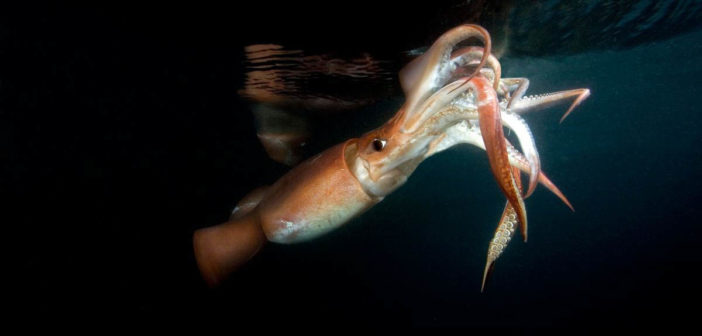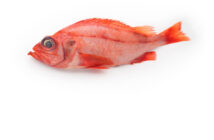Humboldt squid are a large squid that lives throughout the eastern Pacific Ocean. They are part of the flying squid family and are known to eject themselves out of the water to escape from predators. While these squid were once found no further north than California, warming waters along the coast of British Columbia have resulted in Humboldt squid extending their range much further north. Sightings of Humboldt squid have become common off the coast of British Columbia since the early 2000s and they can even be found as far north as Alaska.
Humboldt squid are the largest species of flying squid with bodies, also known as mantles, as long as 1.2 metres and tentacles which add another metre. They grow rapidly and can weigh over 50 kilograms. Incredibly, this rapid growth occurs during their relatively short lifespan of one to two years. Humboldt squid have a tough, thick-walled mantle, eight arms covered with 100 to 200 powerful hooked suckers and two longer feeding tentacles. Like other cephalopods (octopus, squid and their relatives), Humboldt squid have specialized pigment cells called chromatophores that enable them to change colour, as well as bioluminescent organs that produce light, called photophores. Humboldt squid use these in combination to camouflage, communicate and to make their displays easier to see in the dark. They earned the nickname “diablo rojo” or “red devil” because of the red and white flashing display they exhibit when captured by fishers. Researchers have identified 28 colour and “flashing” patterns in Humboldt squid that could have specific meanings and appear to be used in different combinations – much like we use letters in the alphabet to form specific words and sentences. These different combinations of colour and light may help coordinate attacks on prey or help avoid injuring each other as they feed in groups.
Humboldt squid reproduce via internal fertilization and lay at least one million eggs at a time. In their short lifetimes, females may lay as many as 20 million eggs, the most of any known cephalopod. Males die shortly after mating and females die shortly after they lay their last brood of eggs. After the eggs hatch, Humboldt squid grow from about one millimetre to well over one metre in length – in just one year. To support this high growth rate, Humboldt squid are voracious predators and have been known to decimate populations of small fishes or smaller squids, their main prey sources, when their numbers explode. This species of squid is also known to exhibit cannibalism, but usually only on juvenile squids. Adult Humboldt squid undergo vertical migrations throughout the day, coming up from the ocean depths to surface waters at night to feed and then back down to depths of 800 to 1,000 metres, or deeper, during the day. Several species feed on Humboldt squid throughout their different stages of life, but adults are a favourite food of sperm whales, billfishes, like marlin and swordfish, and other very large predators.
Humboldt squid reproduce via internal fertilization and lay at least one million eggs at a time. In their short lifetimes, females may lay as many as 20 million eggs, the most of any known cephalopod. Males die shortly after mating and females die shortly after they lay their last brood of eggs. After the eggs hatch, Humboldt squid grow from about one millimetre to well over one metre in length – in just one year. To support this high growth rate, Humboldt squid are voracious predators and have been known to decimate populations of small fishes or smaller squids, their main prey sources, when their numbers explode. This species of squid is also known to exhibit cannibalism, but usually only on juvenile squids. Adult Humboldt squid undergo vertical migrations throughout the day, coming up from the ocean depths to surface waters at night to feed and then back down to depths of 800 to 1,000 metres, or deeper, during the day. Several species feed on Humboldt squid throughout their different stages of life, but adults are a favourite food of sperm whales, billfishes, like marlin and swordfish, and other very large predators.
Though Humboldt squid are fairly well studied, their conservation status is currently unknown and they are listed as Data Deficient on the IUCN Red List of Threatened Species. As an important prey species for charismatic, protected species like sperm whales and an important fishery species for small-scale fishers throughout its range, it is vital that scientists determine population trends and continue to study Humboldt squid.









